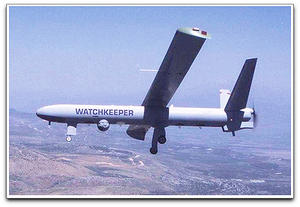UAV updateWatchkeeper surveillance drone "can see footprints through cloud"
Thales UK’s Watchkeeper surveillance UAV is fitted with radar so sensitive, according to its makers, that it can detect not only individual people moving about on the ground — but even the footprints they leave in the dirt; Watchkeeper is a modified version of the Israeli Hermes 450 with added French and British bits and pieces

Thales UK's Watchkeeper UAV with ultrasensitive ground tracking radar // Source: satnews.com
U.K. military surveillance UAVs due to be fielded in Afghanistan within two years are fitted with radar so sensitive, according to its makers, that it can detect not only individual people moving about on the ground — but even the footprints they leave in the dirt.
The UAV in question is the Watchkeeper now under development by Thales UK for the Royal Artillery’s surveillance-drone units. Watchkeeper is a modified version of the Israeli Hermes 450 with added French and British bits and pieces. For now the British army is using ordinary Hermes 450s leased via Thales in Afghanistan, the Phoenix drone having been unceremoniously withdrawn without regret in 2008.
Lewis Page writes that Watchkeeper actually made its first flight in 2008, but did not enter British skies until this year. Thales surveillance UAVs chief Nick Miller, briefing reporters at the Farnborough air show the other day, said that Watchkeepers will start being handed to the Ministry of Defense next year and following government testing will begin to replace Hermes 450s in Afghanistan gradually.
Major Matt Moore of the Royal Artillery also gave a rundown on Hermes 450 operations at the moment in Iraq, showing how the aerial surveillance UAVs can often finger gunmen and bomb-planters before they act — either warning nearby Coalition ground forces of danger, or calling in a strike from armed aircraft.
Page notes that one UAV buzzword at the moment seems to be “pattern of life” — in which soldiers operating airborne surveillance drones become familiar with ordinary activity around villages etc., so that oddities such as groups of people on the move at night are easily picked out for further investigation.
Another is “ISTAR Soak” (ISTAR stands for Intelligence, Surveillance, Target Acquisition and Reconnaissance), where an area of interest is saturated with constant surveillance coverage for a period — a good way to learn about pattern of life, and the only way for “drinking straw” sensors like the Hermes’ electro-optical camera to have much chance of finding enemies without being given a clue where they are first.
Page writes that the main feature that makes an H450 into a Watchkeeper (apart from anti-icing gear, automated takeoff and landing, U.K. airspace certification, etc.) is the Anglo-French I-MASTER radar.
This is not a drinking-straw sensor. Rather, it can sweep wide areas of ground and pick out moving targets. Miller was especially proud of the “change detection” offered by the Watchkeeper, which allows images of the same piece of ground from different times to be compared — detecting vehicle tracks and even footprints which may have been left since the first image was taken.
Likewise a Watchkeeper assigned to ISTAR soak can monitor normal patterns of foot and vehicle traffic around the clock, through clouds and darkness as required. It can tell if local people suddenly stop using a given road or track, for instance, giving an indication that something nasty has been prepared there.
According to Miller, I-MASTER has been known to detect objects as small and low-lying as “keep off the grass” signs in tests.
Page notes that this sort of thing is already available in other UAVs, however — notably the much cheaper Sky Warrior now being delivered to the U.S. Army. The Sky Warrior, too, is armed; so avoiding the need to call in a Harrier or F-16 as at the conclusion of two of Major Moore’s combat videos (in one of these a group of 10 enemy gunmen was hit with a 500-pound bomb which appeared to devastate the entire area they were in. “Four or five” still escaped though, according to the major).
Thales has exhibited Watchkeeper mock-ups with weapons in the past, indicating that Watchkeeper soldiers might in future be able to take out targets themselves rather than go through the time-consuming and error-prone procedure of talking in a fighter pilot to hit just the right spot with cannon fire or bombs.
Page asked whether the British Army had any interest in acquiring such capabilities (even though this might seem likely to lay them open to a turf grab from the RAF, or accusations of taking away business from their fellow artillerymen manning the big guns). “We’re looking at all options,” said the major. “Should it be air based, ground based … the RAF could do it. But armed ISTAR UAV is an option. In time it may happen.”
